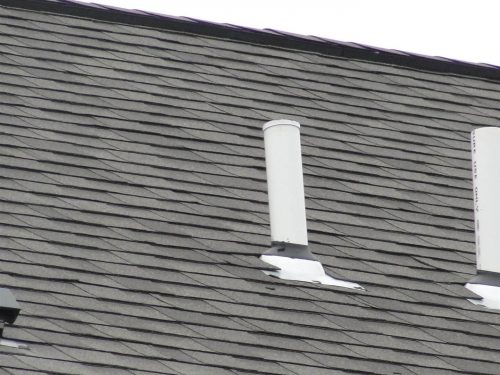Plumbing vents protect plumbing traps. They don’t make fixtures drain faster; in fact, they do the opposite. When it comes to first time home buyers, one of the least understood components of a home seems to be plumbing vents. They’re those pipes sticking up out of the roof that run through the attic and through the rest of the house. All residential plumbing fixtures need to be protected by a plumbing vent. Vents are frequently connected together inside the attic, which allows for fewer penetrations in the roof.
Plumbing vents prevent traps from being siphoned.
Let me repeat that: plumbing vents prevent traps from being siphoned. They also prevent back-pressure on traps, but today the focus is on siphoning. You may have heard that plumbing fixtures will drain faster when they’re vented properly, but it’s not true. The common, improper analogy is to talk about dumping a soda bottle upside down. You watch the water glug out while air replaces it, and this makes it drain slowly. Once you put a hole in the top, water drains out very quickly because air can replace the water as it drains.
This analogy doesn’t hold water because the top side of every plumbing fixture is wide open. The top of a toilet is open. The top of a sink is open. The top of a bathtub is open. If you wanted to re-create the soda bottle analogy, you would need to block off the top of the plumbing fixture and then try to drain the water out. I can’t think of any instance where this could possibly happen.
As I mentioned in last week’s blog post, every plumbing fixture has a trap, which prevents sewer gas from entering the building. When a lot of water drains through a plumbing fixture, it can be enough water to create a siphon effect, which has the potential to pull water right out of the plumbing trap. In my blog about S-traps, I included a quick video clip of an unvented drain having water siphoned out of it, leaving the trap with far less water than it should have had.
To help demonstrate this, I made a video showing the difference between a vented drain and an unvented drain. I used clear tubing for simplicity, but the physics are the same. You’ll notice that the unvented fixture actually drained about 2 seconds faster than the vented drain. This is because the water that had left the fixture was helping to pull water out. With a vented fixture, there’s no pull. The vent allows water to pull air instead. Check it out: https://youtu.be/P8hA6Z1djqo.
If you hear a gurgling noise after water has drained out of a fixture, what you’re hearing is air getting siphoned through the trap. This happens when there is no vent present, the vent is obstructed, or the vent is improperly installed. In next week’s blog post, I’ll discuss air admittance valves; devices that are designed to take the place of individual fixture vents without running pipes through the roof.
Related Posts:
- Plumbing Traps
- S-Traps
- Plumbing vents covered with frost
- Damaged plumbing vent flashing
- Chewed up plumbing vents (darn squirrels)


